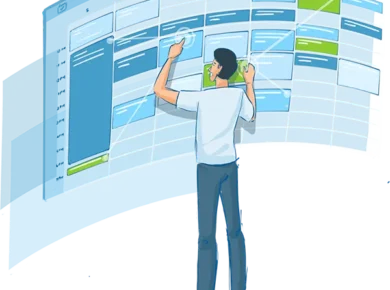Project timeline is one of the very important stages in Project management. It is the stage in which the project is shaped in time. Creating an efficient Project timeline offers the possibility to see at a glance the “big-picture” of the project, with all its tasks, milestones and deadlines.
What is a project
A project represents the sum of the activities and tasks that are carried out to reach a specific result. For the fact that it is a temporary endeavor, it requires the development of distinct technical skills and management strategies.
The essential parameters of any project are scope, budget, quality, and schedule. The last parameter is the project timeline. The interrelationship between all four parameters determines that any change in one of them influences the others and even the outcome of the entire project.
What is project management
To avoid such problems, project management is what deals with the process of planning, organization, and management of resources to complete the specific goals and objectives of the project.
There are different approaches to project management but they all include the same basic stages:
Initiation

determine the nature and scope of the project
Planning

resources, cost and time are adequately planned
Execution

deliverables are executed accordingly to planning
Monitoring and controlling

potential problems can be identified on timer
Closing

includes the formal acceptance of the project and the ending thereof
What is a Project timeline
The Project timeline is the second stage of project management, Planning. The Project timeline is what captures its whole essence: what, how, under what conditions and until when it will be accomplished. In a Project timeline are represented all the tasks, activities, and events that are already accomplished, the ones that are currently being worked on, and also the ones that have to be done in the future.
Regardless of how it is structured, a Project timeline will include the following key elements:
- All the tasks related to the project
- The deadline for each of the tasks
- Start and end date of tasks
- Dependencies between tasks – the relationship between tasks when are interconnected. This helps to organize the work and to approach the tasks in the proper order
- Relevant milestones – marks the end of an important stage of the project. These may be related to concepts, design, development, testing, and, eventually, launch.
How to create a Project timeline
Transposing all the tasks and events in an efficient Project timeline is a procedure that ensures total transparency regarding the stage of execution. At a glance, you can see the deadlines and the progress and this makes it possible to react promptly to any inconsistencies that may appear.
To create an effective project timeline, you need to complete the following 8 steps:
- Understanding and defining the purpose of the project.
The project’s purpose must be clearly defined, accurate and detailed. The harmonious development of the entire Project timeline depends on this step. - Creating a work breakdown structure (WBS).
All that was defined at the previous step must now be broken down into smaller deliverables that will later be used to define tasks and task dependencies. - Creating the tasks necessary for the WBS
The smaller deliverables defined at the previous step will now be used to define the tasks. All of those tasks will help you plan accurately - Determination of project dependencies
Determines which tasks are interconnected and which are the relationships between them. This must be precisely established to ensure the natural order of the Project timeline - Evaluation of the necessary and available resources
Determine who, when and what they do. Balance responsibilities and allocate them accordingly so that the result is as expected - Establishing important milestones
Track the progress of the project through intermediate assessments at predetermined time intervals. This will allow the right measures to be taken on time - Determination of the necessary time for each task
Create accurate estimations for each of the tasks. Consider from the beginning the time limit available for the whole project, so that you fit properly in the Project timeline. - Establishing the Project timeline
Put together all the threads obtained in the above steps and build the Project timeline
How to visualize the Project timeline
For added efficiency, all the above data can be transposed into a visual layout. There are several methods available and should be chosen one that best suits the characteristics of the project and the way of working. Some of these methods are:
Gantt chart, an efficient visual approach that illustrates a project timeline. Includes the start and end time of each task, it shows the dependencies between tasks and also the milestones. Depending on the time length of the project, the Gantt Project timeline can be drawn up for longer or shorter periods, including from several months to several hours.
The PERT chart especially highlights in particular, the completion time of each task to identify the shortest period in which the project can be completed. It illustrates very well the critical path and which tasks are less important.
Pareto charts are usually used to visualize quality control issues and to prioritize problem areas. The method highlights the most important or critical elements in a set
Ishikawa or Fishbone diagrams properly identify the true causes of problems. The diagram looks like a fish and “the head” is the problem that has arisen and the various causes are displayed into the spine.
Simple Project timeline, in a horizontal or vertical visual layout. All the tasks, milestones, intermediate and final deadlines.






